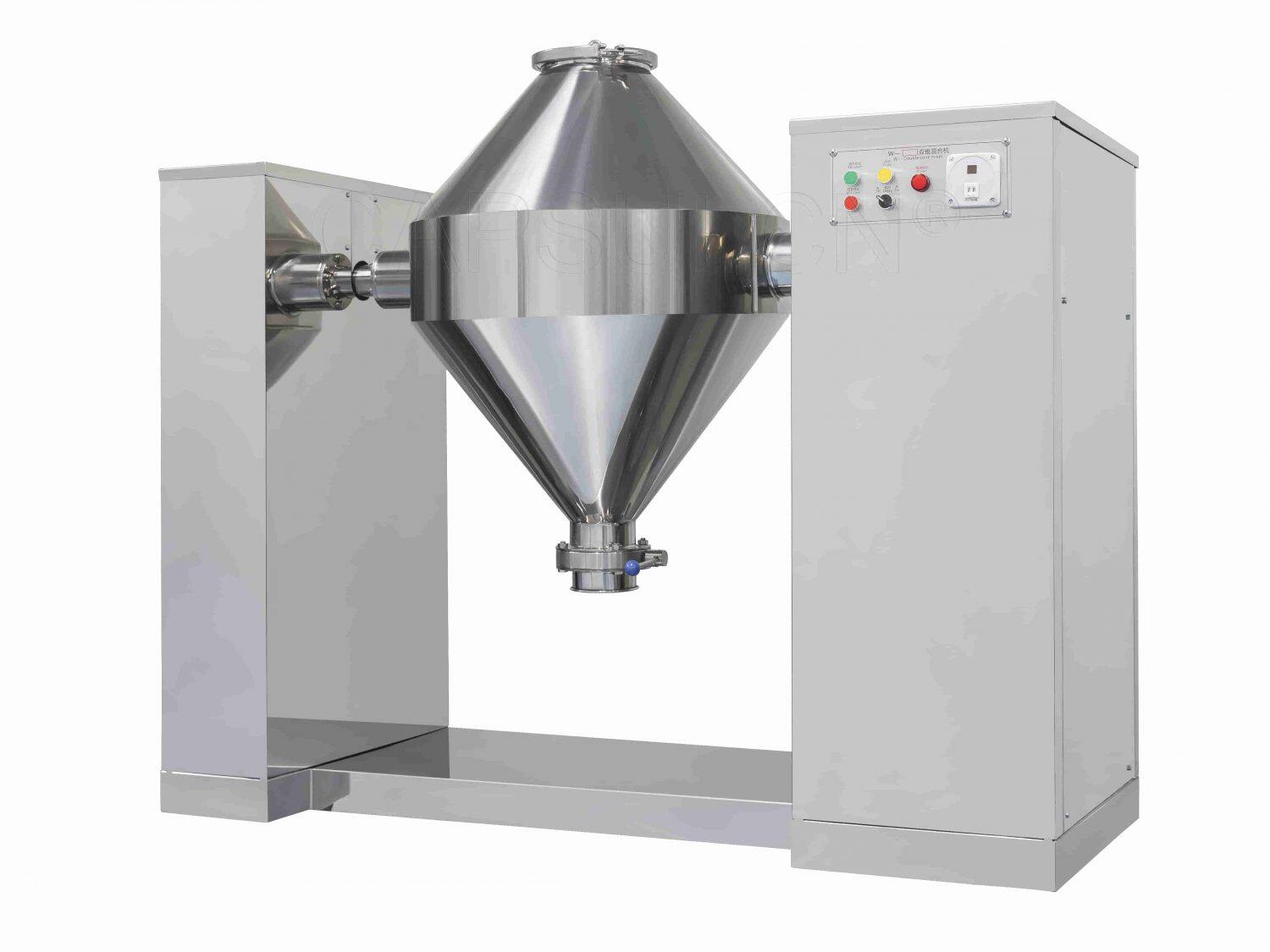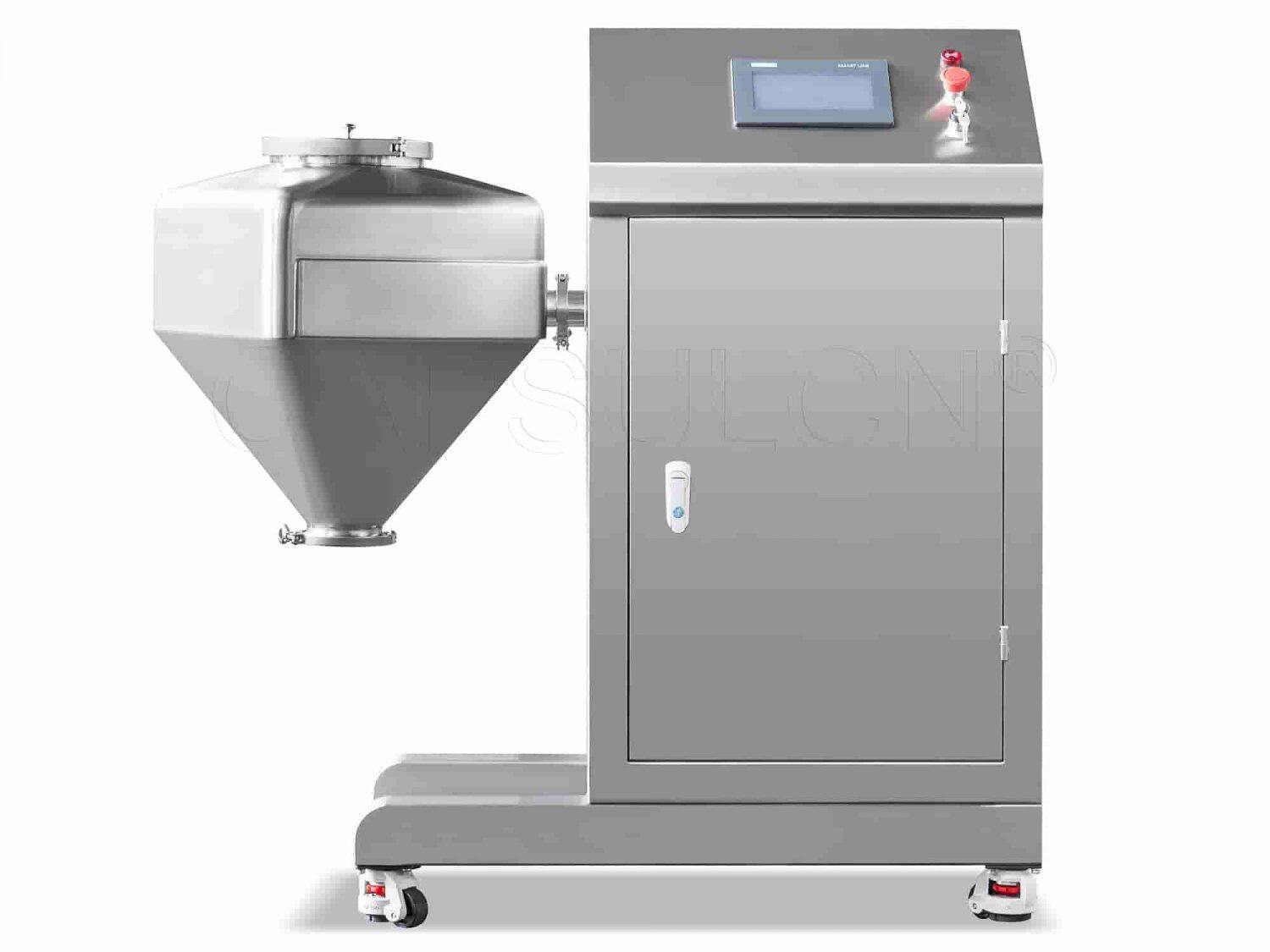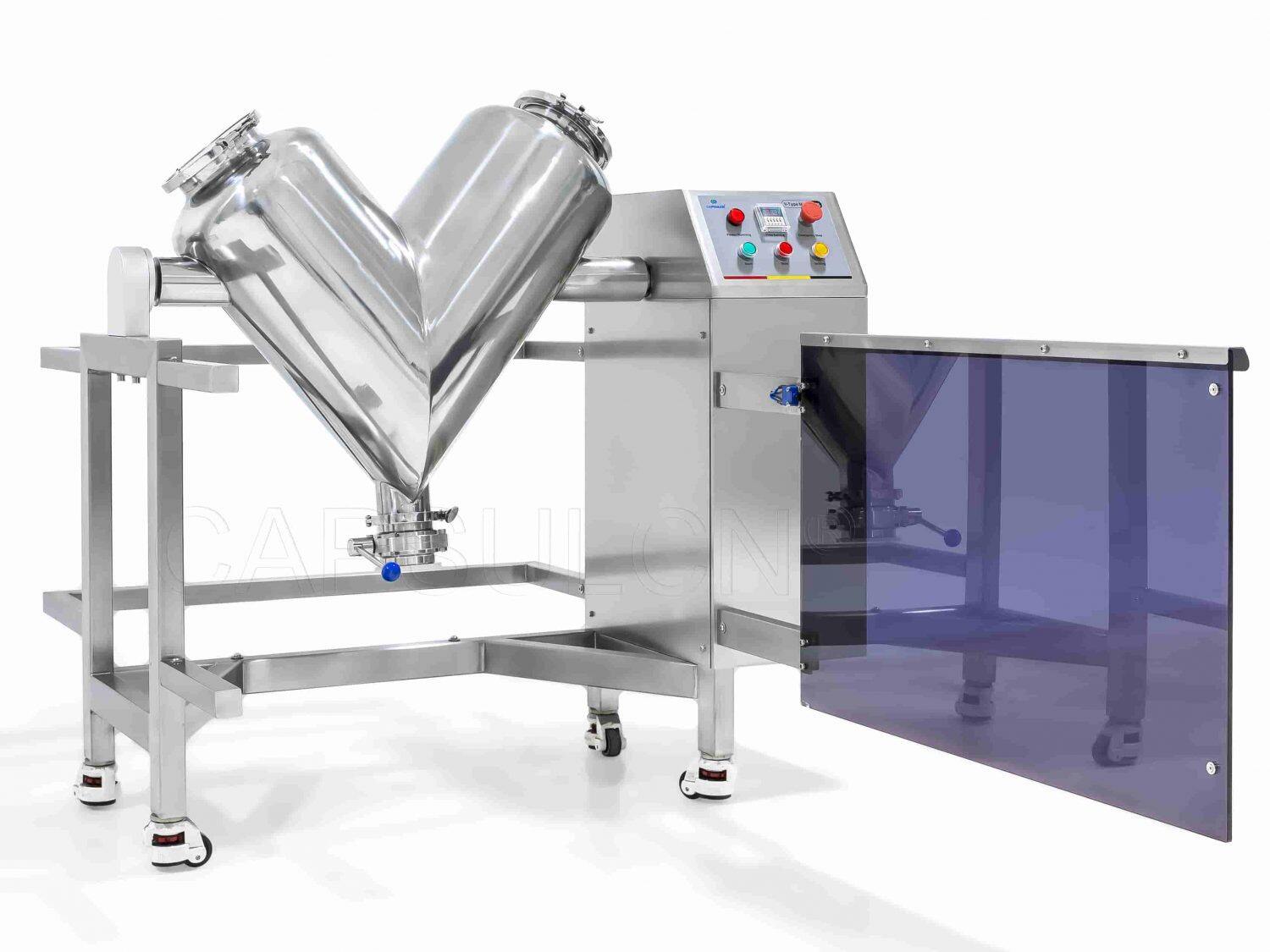Have you ever come across such a situation? Your pharmaceutical production line is ready, and you know every second counts; however, your current mixing equipment is causing delays—uneven mixtures, product waste, and constant adjustments. You begin to feel frustrated and think, "Isn't there a better solution out there?"
The answer lies in using the right equipment. A pharmaceutical cone blender is designed to revolutionize your blending process. It excels at handling delicate materials and ensuring uniform mixing. This guide is here to walk you through everything you need to know about buying a pharmaceutical cone blender. Let's get started!
What is a Pharmaceutical Cone Blender?
A pharmaceutical cone blender is a vital piece of particle processing equipment used in this sector. This kind of machine features a distinctive conical shape. It's designed to gently and efficiently blend dry powders and granules. Most cone blenders can be equipped with an intensifier bar to improve mixing efficiency and increase shear forces. Some advanced models even feature a sprayer system to handle more complicated mixing tasks.

The basic concept of a pharmaceutical cone blender is to tumble. Through this action, the machine can ensure a uniform blend essential for manufacturing consistent and effective medications. Depending on the design, the cone blender can handle various batch sizes. It's an essential tool for aiding in the manufacture of tablets and capsules.
Types of Cone Blenders Used in the Pharmaceutical Industry
If you look around the cone blender market, there are three popular types used by many pharmaceutical companies. They are:
Double Cone Blender
A double cone blender has two cone-shaped shells connected at their bases, with a cylindrical section in the middle. This tumble blender stands out in its gentle tumbling mechanism. It does a great job of mixing free-flowing solid ingredients and fragile or abrasive materials.
The blending process in a double cone blender involves three simple steps:
- Loading: Materials are placed in the chamber. The filling volume is about two-thirds of its capacity to allow room for tumbling motion.
- Blending: The blender rotates around a horizontal axis, tumbling the materials continuously to achieve a uniform mix. The blending time varies based on the type and amount of materials you deal with.
- Discharging: Once blending is complete, the mixture is released through a discharge valve at the bottom.
Pros and Cons:
- Blends gently without product damage.
- Ensures a homogeneous blend due to the continuous tumbling action.
- Suitable for various particle sizes and abrasive materials.
- Easy to clean and maintain with simple construction.
- The mixing time might be longer than that of other types of blenders.
- Limited capacity for very large batches.
- May require frequent adjustments to achieve optimal blending for different formulations.
V Cone Blender
A V cone blender goes by many names, such as a twin shell blender or a V blender. It's made up of two hollow cylindrical shells connected in a V shape. The angle of the V is often around 75 to 90 degrees. V cone blenders are proficient in the efficient blending of fragile and cohesive ingredients.
So, how does a V cone blender work? Let's check it out!
- Loading: Different ingredients are fed into the V-shaped mixing chamber through two separate feed inlets. The chamber is filled to about 50-60% of its capacity to ensure optimal mixing. Or the blending time may increase significantly.
- Blending: This blending action in this machine essentially works by diffusion. As the chamber rotates, materials inside cascade due to gravity. Particles are constantly exposed to new surfaces as they tumble. The blending time can vary depending on the complexity of the mixture.
- Discharging: The mixed product is discharged manually or pneumatically through a hermetically sealed butterfly valve.
Pros and Cons:
- Offers efficient blending with high throughput capabilities.
- Enhances particle movement and interaction for uniform mixing.
- Suitable for continuous operation in large-scale production.
- Compact design saves floor space in manufacturing facilities.
- Can apply more stress to particles, potentially leading to degradation.
- More complex design may result in higher maintenance requirements.
- Typically more expensive compared to double cone blenders.
Square Cone Blender
This is a new variation of pharmaceutical cone blenders. Unlike traditional cone blenders, the square cone blender combines the robust structure of a square chamber with the efficient mixing dynamics of a conical design. This unique combination significantly enhances the mixing efficiency and helps achieve an ultra-uniform blend.

Like its siblings, the workings of a square cone blender are also quite straightforward.
- Loading: Particles to be mixed are loaded into the square-shaped chamber in turns. The chamber is filled to about 50-70% of its total volume to ensure thorough blending.
- Blending: The chamber begins to rotate. The rotation speed is carefully controlled to prevent any degradation of the active ingredients. The square walls of the chamber help to create distinct flow patterns, ensuring that all particles are evenly distributed and blended uniformly.
- Discharging: After achieving the desired mixture, the cone blender stops rotating. The well-mixed particles are then discharged from the chamber from the outlet at the bottom.
Pros and Cons:
- Combines robust structure with efficient mixing dynamics.
- Provides ample space for material movement, enhancing blend uniformity.
- Improved scalability for different production sizes.
- Easier to discharge and clean with the square chamber design.
- The distinct design may call for specific maintenance.
- Potentially higher energy consumption due to the combination of shapes.
- May not be as widely available, limiting options for sourcing and support.
Comparing Pharmaceutical Cone Blenders with Other Industrial Blending Equipment
Check out this chart to find out the differences between cone blenders and other types of blending machines. It should help you determine which one best fits your specific blending needs.
| Feature | Double Cone Blender | V Cone Blender | Square Cone Blender | Ribbon Blender | Paddle Blender |
| Design Shape | Double-conical shape with two cones | V-shaped cone | Square-shaped cone | Horizontal trough with ribbon agitators | Horizontal trough with paddle agitators |
| Mixing Efficiency | High for homogeneous blends | Excellent for uniform mixing | Good for bulk blending | Very high, excellent for continuous blending | Moderate to high, depending on design |
| Suitable Materials | Abrasive and fragile ingredients | Sensitive and cohesive materials | Bulk powders and granulated materials | Dry, free-flowing powders, granules, and some wet mixtures | Dry and wet mixing, fragile ingredients, and cohesive materials |
| Capacity Range | Small to medium | Small to medium | Medium to large | Large to very large | Medium to large |
| Mixing Action | Rotational movement with minimal shear | Rotational and tumbling action | Rotational with some cascading | Ribbon agitators provide thorough mixing | Paddle action offers gentle to moderate mixing |
| Ease of Cleaning | Good – smooth surfaces with minimal dead corners for easier cleaning | Moderate – corners and seams require thorough cleaning | Moderate – corners may require more effort | Moderate – Complex ribbons take longer to clean | Good – Easy to clean with accessible paddle assemblies |
| Energy Consumption | Lower compared to other cone blenders | Moderate, depending on the specific design | Moderate to high due to producing higher shear | Moderate due to mainly mixing dry solids | Higher due to mixing both dry and wet materials |
| Advantages | Excellent for blending abrasive ingredients | Gentle mixing preserves material integrity | Increased capacity and mixing efficiency | Ideal for large-scale and continuous operations | Versatile and adaptable to various materials |
| Limitations | Limited capacity compared to larger blenders | May not handle very large batches efficiently | Higher energy usage and initial investment | Not ideal for blending brittle materials | May not achieve as uniform mixing as ribbon blenders |
| Typical Applications | Pharmaceutical formulations, supplements | Blending heat-sensitive pharmaceuticals | Bulk pharmaceutical powders, large-scale blending | Food processing, chemical industries, large-scale pharma | General industrial mixing, food products, pharmaceuticals |
Tips for Choosing the Right Pharmaceutical Cone Blender
Decided to buy a cone blender? No rush! We'd love to share some handy tips to help you pick the perfect pharmaceutical cone blender.

- Know Your Materials
Start by understanding what you'll be blending. Are you working with dry, wet, fragile, or cohesive ingredients? Each pharmaceutical cone blender has its own strengths, so knowing your stuff ensures you choose a blender that won't mess up your formulation.
- Assess Your Batch Size
How much are you going to blend? If you're dealing with small to medium batches, a double cone or V cone blender might be perfect. For larger quantities, a square cone blender could offer the capacity you need.
- Mixing Efficiency Matters
You want your ingredients to mix uniformly. You can ask the supplier for a video demo of how their blenders perform. Look for the one that offers high mixing efficiency and consistency in every batch.
- Ease of Cleaning is Key
Pharmaceutical standards require impeccable cleanliness. Opt for a blender that's simple to disassemble and clean. Smooth surfaces without hard-to-reach areas can save you a lot of hassle.
- Check for Quality and Compliance
Cone blenders are in direct contact with materials. So, GMP-compliant materials are a must. Invest in a blender made from high-quality materials that can withstand continuous use. Stainless steel is favored in the pharmaceutical industry because it's durable and easy to clean.
- Consider Space and Footprint
Make sure the blender fits comfortably in your production area. Measure your available space and consider the blender's footprint, especially if you're working with limited space.
- Customization Options
Sometimes, off-the-shelf solutions might not meet all your specific needs. Check if the blender can be customized with features like intensifier bars, spray systems, or variable speed controls.
- Budget Wisely
While it's tempting to go for the cheapest option, consider the long-term benefits of a reliable blender. Sometimes, spending a little extra at the start can save you money down the line with better performance and fewer breakdowns.
- Think Ahead about Growing Needs
You probably don't stick to just one kind of material or production size. A versatile blender that can handle different batch sizes or materials can save you from having to buy new equipment as your business expands.
- Look for Reliable Support
If you're new to pharmaceutical cone blenders, post-purchase assistance is needed. Pick a supplier with good customer support, training, and maintenance services. They are beneficial when you encounter issues.
The Bottom Line
To wrap things up, buying a pharmaceutical cone blender in 2024 doesn't have to be overwhelming. Just keep in mind what you really need—like the types of materials you'll be handling and how much you'll be producing. Use the tips from this guide to help you navigate your options and make a smart choice.
Don't forget to check out different suppliers, ask for demos, and look into their after-sales support to find the best fit for you. With the right cone blender, you'll be set to tackle whatever the pharmaceutical world throws your way!